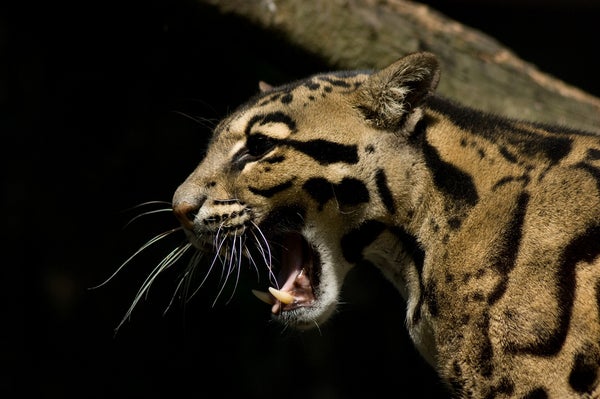This article was published in Scientific American’s former blog network and reflects the views of the author, not necessarily those of Scientific American
Lions and tigers aren’t the only big cats threatened by poaching. According to research published this week in the journal Biological Conservation, the lesser-known clouded leopards (two species from the genus Neofelis) have become the latest target of illegal traders. The trade, much of which is intended for the traditional medicine market, has increased in recent years, apparently because dwindling tiger populations have forced poachers to seek a more readily available target.
“In some illegal markets, clouded leopard skin and bone are now more common than tiger,” lead researcher Neil D’Cruze of the Wildlife Conservation Research Unit at the University of Oxford said in a prepared statement.
The total wild population of the two clouded leopard species is estimated to be around 10,000. The mainland species (N. nebulosi) lives in the mountains and forests of Southeast Asia. The Sunda clouded leopard (N. diardi), which was only recognized as a separate species ten years ago, can only be found on the islands of Sumatra and Borneo. Both species are currently considered vulnerable to extinction. A subspecies, the Formosan clouded leopard (N. n brachyuran) was declared extinct in 2013.
On supporting science journalism
If you're enjoying this article, consider supporting our award-winning journalism by subscribing. By purchasing a subscription you are helping to ensure the future of impactful stories about the discoveries and ideas shaping our world today.
In addition to hundreds of leopard furs and bones, the study found rampant trade in clouded leopard body parts, including claws, whole feet and skulls. Some of the trade, as recently seen with other species, took place in online social media platforms. All of this activity has been illegal since 1972 under the Convention on International Trade in Endangered Species (CITES). According to the study the trade started to spike upwards in 2005 and illegal activity has continued to climb ever since as smugglers tried to supplement their income from tiger products.
More surprisingly, the study documents a massive trade in live leopard cubs and adult cats, which are being sold as pets or for use as tourist attractions. CITES only allows the commercial sale of any descendants of cats that existed in captivity prior to the 1972 ban. Twenty different countries recorded exporting living clouded leopards, fifteen of which do not have their own wild leopard populations. United States tops that list.
The paper paints a highly critical picture not just of the trade but also of captive leopard breeding, which puts the jungle cats into highly unfamiliar situations. The authors wrote that “clouded leopards are...very sensitive to changes in their environment with exposure to novel objects, loud noises and new people documented as stressors.” All of these conditions are present in breeding facilities and they cause abnormally high aggression in males, which have killed at least 25 females in captivity over the past 20 or so years. Captive animals also display “hair plucking, tail chewing, pacing and excessive hiding,” according to the paper.
Things could actually be much worse in facilities that scientists have not been able to officially monitor. Undercover footage cited by the paper revealed clouded leopard cubs at two of the infamous tiger farms in Laos and Thailand, as well as leopard furs. The facilities have been tied to illegal trade in tiger products and to stimulating the demand for wild-caught wildlife, which is considered more potent in traditional medicine.
As the first major study of the clouded leopard trade, the authors wrote that what has been observed to date may just be the tip of the iceberg. They are now calling for better law enforcement to block the illegal trade and for an end to captive clouded leopard breeding where it does not suit conservation purposes.
Photo by Spencer Wright. Used under Creative Commons license
